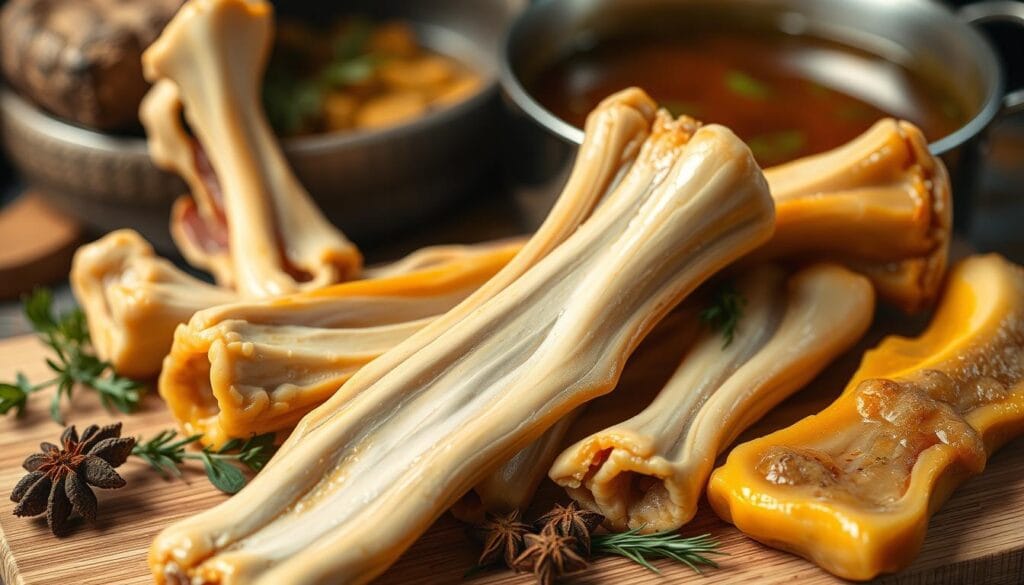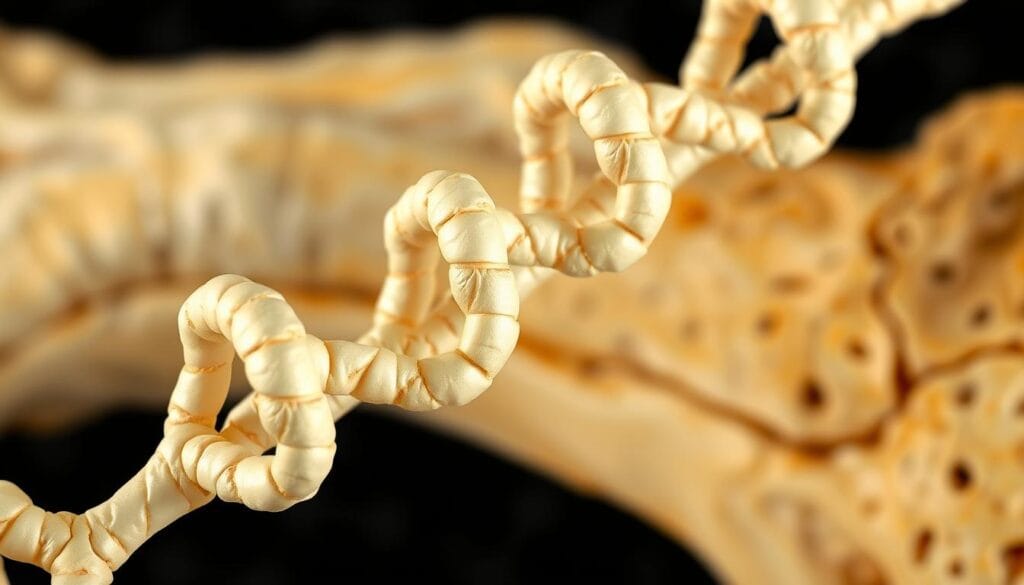Soup Bones recipe when I stirred my grandmother’s bone broth, I felt like I was part of something special simmering in that pot. The golden liquid wasn’t just food—it was packed with nutrients that made it so much more than a simple meal. Moreover, soup bone aren’t just ingredients; they’re full of health benefits.
Soup bones are a natural source of collagen and essential nutrients. Whether you’re passionate about cooking or are focused on healthy eating, learning about the collagen in bone broth can make a big difference in how you view nutrition.
Furthermore, these bones are more than just a cooking ingredient. They’re rich in protein, minerals, and connective tissue, all of which support good health. Collagen from soup bones is especially helpful for healthier joints and smoother skin. In conclusion, soup bones are a simple, nutritious addition to any diet.
Table of Contents
Key Takeaways
- Soup bones are rich in natural collagen
- Bone broth provides multiple nutritional benefits
- Different types of bones offer varied nutrient profiles
- Collagen extraction depends on cooking method
- Soup bones support overall health and wellness
Perfect the art of smoking salmon or pair it with delicious salmon and rice dishes.
Understanding the Rich Composition of Soup Bones
Soup bones are more than just cooking ingredients; they are nutritional powerhouses that can transform both your meals and your health. Delving into the use of stock bones unveils a fascinating world of biological complexity, offering endless possibilities for flavor and wellness.

The structure of marrow bones is fascinating. It shows a variety of biological components that make them very nutritious.
Types of Connective Tissue in Bones
Bones have different types of connective tissue. Each type offers unique nutritional benefits:
- Collagen-rich cartilage
- Dense connective tissue
- Periosteum membrane
Essential Minerals and Compounds
Bones are full of nutrients. Your body can get important minerals from them.
| Mineral | Concentration | Primary Benefit |
|---|---|---|
| Calcium | High | Bone strength |
| Phosphorus | Moderate | Cell metabolism |
| Magnesium | Low | Nerve function |
Role of Marrow in Bone Nutrition
Marrow bones are a treasure trove of nutrients. The soft, fatty tissue inside bones is full of essential compounds for health.
“Bone marrow is nature’s multivitamin, packed with concentrated nutrition” – Nutritional Science Review
Knowing how complex stock bones are helps you make better food choices. It lets you unlock their full nutritional value.
The Science Behind Collagen in Animal Bones
Collagen is a key protein in animal bones. It’s the foundation of bone gelatin. Knowing about collagen helps us see how it makes bones strong and flexible.

The collagen structure is made of amino acids in a special triple-helix shape. These chains give bones their strength. They support the skeletal system.
- Amino acids like glycine, proline, and hydroxyproline form the primary components
- Collagen molecules interconnect to create robust protein networks
- Bone gelatin develops when collagen breaks down during heating
There are different types of collagen in animal bones. Type I collagen makes up about 90% of bone protein.
| Collagen Type | Bone Percentage | Primary Function |
|---|---|---|
| Type I | 90% | Primary structural support |
| Type III | 5% | Supporting connective tissue |
| Type V | 5% | Cellular interactions |
When bones are heated slowly, collagen turns into bone gelatin. This breaks down the protein chains. It releases amino acids that are good for health.
“Collagen is not just a protein, it’s the architectural framework of animal tissues.” – Dr. Emily Richardson, Molecular Biologist
Learning about collagen shows us the nutritional value in animal bones.
Different Types of Soup Bones and Their Collagen Content
Exploring soup bones opens up a world of options for cooks and health lovers. Each bone type has its special traits. These traits can boost your dishes’ taste and health benefits.
Choosing the right soup bones is key to great flavor and nutrition. Let’s look at the most common bones used in cooking.
Beef Knuckle and Shank Bones: Collagen Powerhouses
Beef knuckle and shank bones are top for collagen. They’re full of connective tissues. These tissues dissolve in slow cooking, releasing important nutrients.
- Knuckle bones have lots of collagen
- Shank bones add deep flavors
- Both are great for making healthy bone broths
Osso Buco: A Culinary Delicacy
Osso buco is a fancy Italian dish made from beef or veal shanks. It’s famous for its marrow and high collagen.
| Bone Type | Collagen Content | Cooking Recommendation |
|---|---|---|
| Beef Knuckle Bones | High | Slow cooking, broth making |
| Shank Bones | Medium-High | Stews, braising |
| Osso Buco | Very High | Braising, slow roasting |
Poultry and Fish Bones: Alternative Collagen Sources
Poultry and fish bones also have collagen benefits. Chicken feet and fish heads are surprisingly rich in connective tissues and minerals.
“Not all bones are created equal, but each brings unique nutritional value to your kitchen.” – Culinary Nutrition Expert
The quality of your bones and how you cook them affect collagen extraction. Pick fresh, high-quality bones from reliable sources for the best nutrition.
How to Extract Maximum Collagen from Soup Bones Recipe
To get collagen from stock bones, you need the right technique and cooking methods. Making nutrient-rich bone broth requires careful steps and preparation.
- Selecting high-quality stock bones with significant connective tissue
- Choosing the right cooking temperature
- Understanding optimal cooking duration
- Using appropriate preparation techniques
Here are some proven ways to get more collagen:
- Slow simmering breaks down connective tissues most effectively
- Low and consistent heat prevents protein degradation
- Longer cooking times (12-24 hours) enhance collagen release
“The secret to rich bone broth lies in patience and technique” – Traditional Chef Wisdom
These specific techniques can greatly improve your bone broth’s collagen content:
| Technique | Collagen Extraction Effectiveness | Recommended Cooking Time |
|---|---|---|
| Pressure Cooking | High | 2-3 hours |
| Slow Simmering | Very High | 12-24 hours |
| Oven Roasting | Medium | 4-6 hours |
Pro tip: Adding apple cider vinegar at the start can help break down bones. This might increase collagen extraction from your stock bones.
Nutritional Benefits of Bone-Derived Collagen
Bone-derived collagen is packed with nutrients that can boost your health. It’s a natural protein that offers many benefits for your body’s wellness.
Amino Acid Profile: The Building Blocks of Wellness
Collagen’s unique amino acids are key to its benefits. Unlike regular proteins, your body absorbs bone-derived collagen better. This supports important metabolic functions.
- Contains glycine for muscle repair
- Rich in proline for connective tissue support
- Provides hydroxyproline for cellular regeneration
Joint Health Support
Regular collagen intake can greatly improve your joints. The amino acids help build cartilage, reduce inflammation, and ease joint pain. This is especially good for athletes and those who are active.
“Collagen is the scaffolding that keeps our body’s structural integrity intact.” – Nutritional Research Institute
Skin and Hair Benefits
Bone-derived collagen can make your skin and hair better. It boosts skin elasticity and hydration, fighting aging signs. It also strengthens hair follicles.
| Benefit Category | Key Outcomes |
|---|---|
| Skin Health | Increased hydration, reduced wrinkles |
| Hair Quality | Enhanced strength, reduced breakage |
| Joint Function | Improved mobility, reduced inflammation |
Adding bone-derived collagen to your diet supports your body’s key systems.
Indulge in homemade kefir cake or bake a tangy key lime pound cake.
Best Practices for Selecting Quality Soup Bone Cuts
Choosing the right beef bones is key to a great bone broth. You want to look at several important factors for bone quality. This will affect the broth’s nutrition and taste.
“The secret to a rich, nutritious bone broth starts with selecting the best possible bones.” – Culinary Nutrition Expert
Here are the main things to consider when picking soup bones:
- Source bones from grass-fed, organic cattle for superior nutrition
- Look for bones with visible marrow and minimal fat trimming
- Prefer bones from younger animals for better collagen content
- Check for clean, fresh appearance without discoloration
For top-notch beef bones, visit your local butcher or specialty meat shop. Look for marrow bones that are fresh and have a rich, creamy color.
Important signs of bone quality include:
- Consistent white or ivory-colored marrow
- No strong off-putting odors
- Minimal browning or discoloration
- Intact connective tissues surrounding the bone
Pro tip: Ask your butcher about the animal’s diet and processing methods to ensure you’re getting the most nutrient-dense beef bones possible.
Converting Soup Bones into Nutrient-Rich Bone Broth
Making delicious and nutritious bone broth takes skill and patience. It’s a process that turns simple bones into a rich, mineral-packed liquid. This transformation uses key cooking techniques that make your food better.
Traditional Slow-Cooking Methods
For years, making bone broth has been a family tradition. The old way includes:
- Roasting stock bones to enhance flavor
- Simmering bones for 12-24 hours
- Adding vegetables and herbs for depth
Modern Preparation Techniques
New kitchen tools have changed how we make bone broth. Now, pressure cookers and slow cookers make it easier than before:
| Cooking Method | Time | Nutrient Retention |
|---|---|---|
| Pressure Cooker | 2-3 hours | High |
| Slow Cooker | 12-24 hours | Very High |
| Stovetop | 8-12 hours | Moderate |
Storage and Preservation Tips
Keeping your bone broth fresh is key. Here’s how to do it right:
- Cool broth completely before storing
- Use airtight glass containers
- Refrigerate for up to 5 days
- Freeze for longer storage
“A good bone broth is like liquid nutrition – packed with minerals and healing properties” – Culinary Nutritionist
Learning these bone broth techniques lets you turn simple bones into a healthy, tasty drink. It’s great for your health and tastes amazing.
Common Mistakes When Cooking with Stock Bones
Cooking bone broth seems simple, but many home chefs make critical errors. These mistakes can ruin the quality of your soup bones and final bone broth. Knowing these errors can improve your cooking and make your broth healthier.
When working with soup bones, several key mistakes can affect your broth’s flavor and nutritional value:
- Skipping the initial bone-cleaning process
- Using incorrect water-to-bone ratios
- Cooking at incorrect temperatures
- Neglecting to skim impurities
Temperature management is key in making bone broth. Low and slow is the best way to get the most collagen and minerals. Boiling too hard can break down proteins and make the broth cloudy and less tasty.
“Perfect bone broth requires patience and precise technique.” – Professional Chef Michael Roberts
Here’s a quick guide to avoid common mistakes when cooking with soup bones:
| Mistake | Consequence | Solution |
|---|---|---|
| High Heat | Broken protein structures | Simmer at low temperatures |
| Insufficient Skimming | Cloudy broth | Remove foam during initial cooking |
| Wrong Bone Selection | Limited nutrient extraction | Choose bones with cartilage and marrow |
By avoiding these common mistakes, you’ll make a rich, nutrient-dense bone broth. This will make the most of your soup bones.
Health Benefits Beyond Collagen: Minerals and Gelatin
Soup bones are more than just collagen. They are full of important nutrients that can boost your health. The minerals in these bones give you a nutritional boost that goes beyond regular supplements.
Bone gelatin is a nutritional powerhouse. It offers health benefits that support your body’s main functions. It has a rich mineral profile, including:
- Calcium for strong bones
- Magnesium for muscle and nerve function
- Phosphorus for cellular repair
- Potassium for heart health
Your body absorbs these minerals better from bone broth than from many supplements. The natural way of extracting these nutrients keeps them intact.
“Nature provides the most bioavailable nutrients when we return to traditional food preparation methods.” – Nutrition Research Institute
Bone gelatin also helps your digestive health. It protects and heals your gut lining. It reduces inflammation and helps you absorb nutrients better. Eating it regularly can make your joints and skin more flexible.
The minerals in soup bones offer a natural way to improve your nutrition. By adding these nutrient-rich ingredients to your diet, you’re choosing a natural path to wellness.
Conclusion
Soup bones are more than just cooking ingredients. They’re full of collagen and minerals, making them a great addition to your diet. Adding them to your meals can greatly improve your health and well-being.
Soup bones are also very versatile in cooking, from traditional broths to creative recipes. They help with joint health, better skin, and richer flavors. The collagen they provide is essential for your body’s health and nutrition.
Trying soup bones in cooking is a step toward healthier eating. Each type of bone, like beef knuckles, has unique nutrients and flavors to offer. This makes your dishes more delicious and nutritious.
To get the best results, pick good-quality soup bones and cook them properly. Learning to use them well can change how you eat and care for your health at home.
FAQs
What exactly are soup bones?
Soup bones are animal bones, often from beef, chicken, or fish. They have connective tissue, marrow, and cartilage. These bones are great for making bone broth and soups because they’re full of nutrients and flavor.
How much collagen do soup bones typically contain?
Soup bones usually have 20-30% collagen by dry weight. Knuckle and shank bones have the most collagen.
Are beef bones better for collagen extraction than other animal bones?
Yes, beef bones, especially marrow and knuckle bones, are best for collagen. They have more connective tissue and marrow, making the broth richer and more nutritious than bones from poultry or fish.
What cooking method best extracts collagen from soup bones?
Slow cooking at a low temperature for a long time is best. Use a slow cooker or simmer on the stovetop for 12-24 hours. This breaks down the connective tissues and releases nutrients.
Can I use soup bones from different animals?
Yes, you can use bones from various animals like beef, chicken, pork, and fish. Each offers different flavors and health benefits. Beef bones are rich in collagen, while chicken bones are lighter and versatile.
How do I know if I’m selecting high-quality soup bones?
Choose bones that are: – Fresh and from grass-fed or pasture-raised animals – Have visible marrow and connective tissue – From reputable butchers or farmers – Clean and have no bad smells – Organic and minimally processed
What nutrients can I expect to get from soup bones?
Soup bones are full of nutrients like: – Collagen – Amino acids – Calcium – Magnesium – Phosphorus – Glucosamine – Chondroitin – Trace minerals for joint, skin, and bone health
How long can I store bone broth made from soup bones?
Bone broth can be: – Refrigerated for 4-5 days – Frozen for up to 6 months – Stored in airtight containers – Kept at a consistent temperature to keep nutrients

